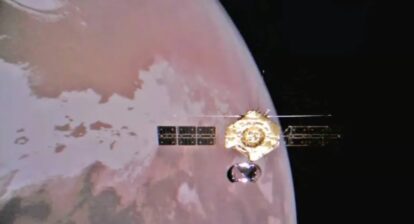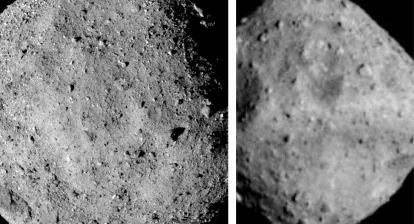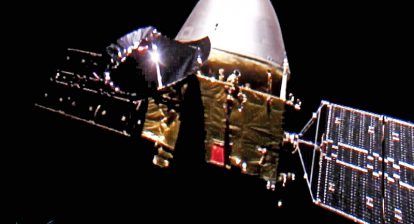NASA’s Perseverance rover – its most ambitious mission yet – lands on Mars on February 18, 2021!
On July 30, 2020 NASA launched Perseverance – part of its Mars Exploration Programme, a long-term effort of robotic exploration of the Red Planet – from Cape Canaveral Air Force Station, Florida. After traveling nearly six-and-a-half months and 300 million miles (482.8 million km), and after nail-biting seven minutes of entry, descent, and landing (EDL) known as “seven minutes of terror”, Perseverance landed at Jezero Crater on February 18, 2021. These seven minutes are so fast that communication between the rover and mission control was not possible (there is an 11 minute delay for signals to reach Earth from Mars). The spacecraft was therefore on its own while it attempted this amazing landing. On approach to Mars, the rover shed its cruise speed that had helped it to reach its destination and then entered the planet’s atmosphere at 12,100 mph (19,500 kph). Its heat shield initially protected it during the descent and helped slow it down. About 7 miles (11 kilometers) above the surface, the spacecraft deployed its 70.5-foot-wide (21.5 meters) supersonic parachutes — the largest parachutes ever sent to another planet. As the heat shield separated, it also jumpstarted the probe’s Terrain-Relative Navigation system. This is another first in space-exploration – a new autopilot technology to help guide the rover to a safe landing on Mars.
Previous rovers have landed in the general vicinity of areas targeted for study but this means a lot of time is spent finding the exact location preferred by researchers. Because it is so hard to land precisely on scientifically rich locations, Perseverance’s Range Trigger technology reduces the size of the landing ellipse (an oval-shaped area around the landing target) by more than 50 percent, helping put the rover on the ground closer to its prime target than previously possible, avoiding hazards that could have resulted from a larger ellipse. This precise landing gives scientists access to more high-priority sites with environments that could have potentially supported past microbial life.
The nail-biting EDL is shown in this animation:
Not only is this an extremely ambitious mission, it was rendered even more so during the pandemic. So, the cheers that erupted in mission control at NASA’s Jet Propulsion Laboratory, when controllers confirmed that Perseverance rover had landed, were even more compelling.
Engineers immediately started analysing the data flowing back from the spacecraft. One of the first things we saw were the images from the surface of the Red Planet. These come from Perseverance’s Hazard Avoidance Cameras (Hazcams), which help with driving. The clear protective covers over these cameras are still on.

First Ever Image of Mars sent by Perseverance Rover using it onboard Front Left Hazard Avoidance Camera A. Image credit: NASA/JPLE-Caltech

Image of the area in back of Perseverance using Rear Right Hazard Avoidance Camera. Image credit: NASA/JPL-Caltech
This ambitious mission has lofty science goals for Mars exploration, including questions about the potential for life. Perseverance will not only seek signs of habitable conditions in Mars’ ancient past, but it will also search for signs of past life. This will likely be microbial life – we shouldn’t be expecting dead little green men.
The rover carries a drill that can collect core samples of the most promising rocks and soils and set them aside in a “cache” on the surface of Mars, to be collected and brought back to Earth by a later mission. The landing site is an ancient 820-foot-deep (250 m) lake bed known as Jezero Crater, which was probably filled with water about 3.9 billion to 3.5 billion years ago. This also has an ancient river delta, where water probably once flowed, so there is potential for a lot of sediment. Mission scientists therefore chose Jezero Crater as the most promising places to look for evidence of ancient microbial life, and to collect samples for future return to Earth.

Jezero Crater on Mars. Image: NASA/JPL-Caltech
This mission will also demonstrate technologies and gather knowledge to aid future human expeditions to Mars, including “testing a method for producing oxygen from the Martian atmosphere, identifying other resources (such as subsurface water), improving landing techniques, and characterizing weather, dust, and other potential environmental conditions that could affect future astronauts living and working on Mars“.
On board, Perseverance carries Ingenuity – a helicopter destined to become the first spacecraft to attempt powered flight on another planet. Ingenuity is a technology demonstration to test powered flight and will perform a series of flight tests over a period of 30 sol (Martian days) that will begin in spring 2021.
During their first press conference post landing, NASA and JPL scientists revealed where the rover landed.

The location where Perserverance rover landed on Mars, with arrow pointing to exact site. Image credit: NASA/JPL-Caltech
What’s next? Perseverance will spend the next couple of days checking out its instruments. Then will come the next big step – of putting driving and navigation software on the rover. After this has been done successfully, the actual driving over the surface will start and the onboard helicopter, Ingenuity, will be tested. Soon after, sample collection will begin from the landing site and then from the delta area.
Before launch, a plaque was attached to the rover, commemorating the pandemic its home planet is going through. Now that Perseverance has found its forever home on Mars, the plaque will be a reminder of the joy, hope and excitement this little robot brought to the world during this difficult time.
(Read about other missions that reached Mars this month UAE’s Hope and China’s Tianwen-1)






